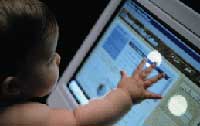Adapting Key Concepts for Different Ages and
Abilities
The Key
Concepts are the foundation of the theoretical
famework of Media Education and the Key Questions
are the inquiry tools for exploring these
theoretical concepts. The questions must be
simplified for younger children as well as for
those with limited vocabulary or language ability.
And they can be expanded for more sophisticated
inquiry by teens, college students and adults. When
children reach their teen years, and/or become more
skilled in media literacy, more complex analysis is
possible.
Age 0-2: The Senses Awaken

Age 2-5: Language Builds Curiosity
It is important, for example, to encourage the habit of asking questions about media, to learn media vocabulary and to practice talking about what they see and hear and how it makes them feel. Children’s videos (or TV series) by quality producers that incorporate developmental skills can be rich sources for segments that can be used to help children grasp the essence of each Key Question.
Age 6-8: Learning to Read
Children also need a rich vocabulary to be ready to read and the kinds of media they are exposed to can either enhance or impede vocabulary development. Some researchers indicate that a rich well-designed educational program can add thousands more words to a child’d vocabulary than a formulaic Saturday morning cartoon.
In addition, the more young children can be exposed to different interpretations of reality, the more open they will become to accepting different ways of thinking, exploring different solutions and valuing cultural differences. Excellent tools can be picture books, videos or audio programs that tell similar stories from different perspectives thereby creating opportunities to ask questions such as #3: “What do I think and feel about this?” or #4: “Is anyone left out?”
Despite the common accusation that kids of this age shouldn’t use media at all, media educators would suggest that just as kids need to be read to everyday and exposed to print-rich environments in order to become print literate, they also benefit from exposure to and exploration of media in order to become media literate. Whether print or electronic media, you can’t make someone literate by keeping them away from it.
Age 9-11: Think Logically but not Abstractly
Age 12+: Learning to Handle Complexity
Production can involve multi-step projects using powerful multi-media tools that demand not just envisioning but planning, organizing, executing and learning from others’s feedback. Most of the activities are are quite suitable for young people in both Middle and High School. As they prepare to leave high school, students should also be encouraged to reflect on their own moral, ethical and spiritual concerns related to media representations and to perfect their communications skills in order to take their place as citizens of a democracy and empowered members of a global media culture.
Each Child Unique
What is important is that parents, teachers and caregivers be flexible and adapt the process to the child. Although the CML MediaLit Kit™ provides a variety of tools for questioning the media, we welcome and encourage additional adaptations and specialized applications as well as research relating child development to the teaching of media literacy.